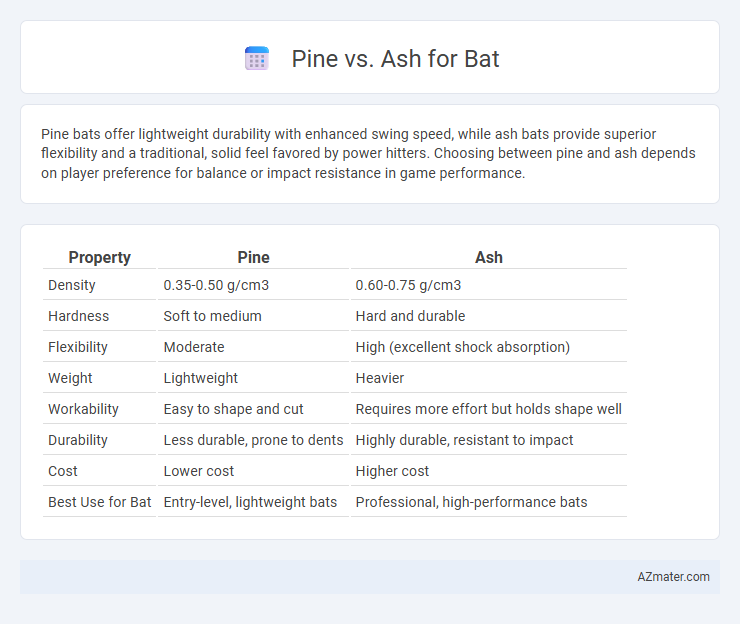Pine bats offer lightweight durability with enhanced swing speed, while ash bats provide superior flexibility and a traditional, solid feel favored by power hitters. Choosing between pine and ash depends on player preference for balance or impact resistance in game performance.
Table of Comparison
| Property | Pine | Ash |
|---|---|---|
| Density | 0.35-0.50 g/cm3 | 0.60-0.75 g/cm3 |
| Hardness | Soft to medium | Hard and durable |
| Flexibility | Moderate | High (excellent shock absorption) |
| Weight | Lightweight | Heavier |
| Workability | Easy to shape and cut | Requires more effort but holds shape well |
| Durability | Less durable, prone to dents | Highly durable, resistant to impact |
| Cost | Lower cost | Higher cost |
| Best Use for Bat | Entry-level, lightweight bats | Professional, high-performance bats |
Introduction to Pine and Ash as Bat Materials
Pine and ash are popular wood choices for baseball bats due to their unique characteristics and performance attributes. Pine is lightweight and offers a softer feel, making it suitable for younger or recreational players seeking enhanced swing speed and control. Ash is known for its flexibility, durability, and excellent shock absorption, providing professional-level performance with a larger sweet spot and increased power potential.
Physical Properties: Pine vs Ash
Pine bats are lighter and less dense, offering greater swing speed but reduced durability compared to ash bats. Ash bats feature a more flexible grain structure, providing enhanced shock absorption and a larger sweet spot for improved ball control. The hardness and tensile strength of ash make it more resistant to cracking, while pine's softer composition results in quicker wear under high-impact hits.
Weight and Balance Differences
Pine baseball bats are generally lighter than ash bats, offering improved swing speed and better maneuverability for players seeking quick acceleration. Ash bats have a more balanced weight distribution, providing enhanced control and a solid feel through the hitting zone, which many players prefer for precision. The difference in density between pine and ash wood results in pine bats being less dense and thus lighter, while ash bats remain favored for their combination of durability and balanced weight.
Durability and Lifespan Comparison
Ash wood exhibits greater durability and lifespan for bats compared to pine, making it a preferred choice for professional players. The dense grain structure of ash provides superior shock absorption and resistance to wear, extending the bat's usability over time. Pine bats, being softer and less dense, tend to dent and crack more easily, resulting in a shorter functional lifespan.
Performance: Power and Flexibility
Pine bats deliver exceptional power due to their lightweight structure, enhancing swing speed and ball exit velocity, making them ideal for hitters prioritizing power. Ash bats offer superior flexibility and durability with their grain structure, providing excellent shock absorption and a balanced feel during swings. Players seeking a blend of strong impact and responsive feedback often prefer ash for its consistent performance under various playing conditions.
Cost and Accessibility
Pine bats are generally more affordable due to the abundance and faster growth of pine trees, making them a cost-effective choice for amateur and intermediate players. Ash bats, while typically pricier, offer superior durability and a balanced feel favored by professionals, available in specialty stores and select sporting goods retailers. Accessibility of pine bats is higher in mass-market outlets owing to their cost-effectiveness, whereas ash bats often require purchase through dedicated baseball equipment suppliers.
Popularity Among Professional Players
Ash bats dominate professional baseball leagues due to their superior durability and larger sweet spot, contributing to powerful, consistent hits favored by many Major League players. Pine bats, gaining traction for their lighter weight and enhanced swing speed, are increasingly popular among players seeking improved bat control and faster reaction times. The ongoing preference for ash versus pine ultimately depends on individual player style, with a noticeable shift towards pine in younger, speed-focused athletes.
Environmental Impact and Sustainability
Pine bats have a lower environmental impact due to faster growth rates and renewable harvesting practices compared to ash, which grows slower and is often sourced from overexploited forests. Ash wood bats typically require more energy-intensive processing, increasing their carbon footprint, whereas pine bats benefit from sustainable forestry certifications that promote ecosystem balance. Choosing pine aligns with eco-friendly sports equipment preferences by supporting renewable materials and reducing deforestation risks associated with ash.
Ideal Uses for Pine and Ash Bats
Pine bats are ideal for youth players and beginners due to their lighter weight and affordability, offering enhanced control and easier swing speed development. Ash bats, known for their flexible grain structure, provide durability and a balanced feel, making them suitable for intermediate to advanced players seeking a blend of power and control. Both woods impact performance differently, with pine excelling in affordability and ease of use, while ash delivers strength and responsiveness for competitive play.
Choosing the Right Bat: Pine or Ash?
Choosing between pine and ash for a baseball bat depends on durability and performance preferences. Pine bats offer greater hardness and durability, making them ideal for power hitters who want a longer-lasting bat, while ash bats provide superior flexibility and a lighter swing weight, benefiting players who prioritize control and swing speed. Considering factors like weight distribution, wood grain structure, and impact resistance can help players select the best bat material for their playing style and league requirements.

Infographic: Pine vs Ash for Bat
 azmater.com
azmater.com